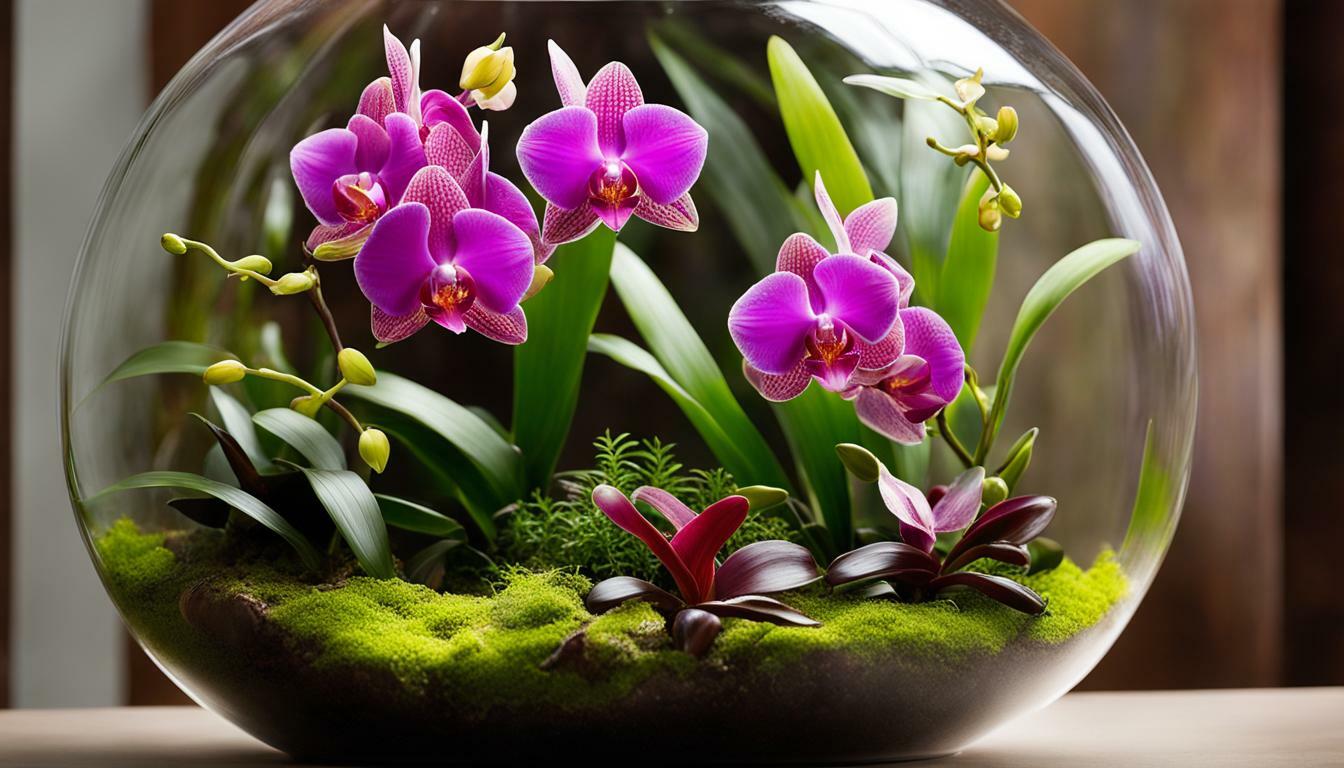Are you ready to dive into the world of terrarium plants orchids and become a master of indoor orchid care? Creating an orchid terrarium is a fantastic way to cultivate these beautiful plants in a controlled environment, ensuring they receive the ideal conditions they need to thrive and bloom. With the right knowledge and care, you can enjoy the beauty of orchids right in your home.
- Choosing orchid varieties that can handle low to medium levels of light and moderate temperatures is crucial for successful terrarium cultivation.
- Consider adding filler plants and companion plants to enhance the appearance of your orchid terrarium.
- Prior to setting up the terrarium, make sure to clean and sterilize the tank to prevent the spread of diseases that can harm your orchids.
- Utilize an eggshell crate as the base layer instead of traditional substrates like sand, soil, or gravel.
- Props such as cork, driftwood, or moss can be added to cover the orchid pots and create a more natural look.
- Properly control the airflow, humidity levels, light, temperature, and watering and fertilizing techniques to create the optimal conditions for your orchids.
- An orchid terrarium provides a contained environment with specific atmospheric conditions that are perfect for orchids to thrive.
Understanding Terrarium Plants Orchids
Before diving into the world of terrarium plants orchids, it’s important to understand the different terrarium ideas and the best orchid species that thrive in this environment. Creating an orchid terrarium is a great way to control the temperature, light, humidity, and airflow to help orchids thrive and bloom.
When it comes to selecting orchid species for terrariums, it’s crucial to choose varieties that can handle low to medium levels of light and moderate temperatures. Some excellent choices include Paphiopedilum orchids, miniature Phalaenopsis, Masdevallia orchids, and Pleurothallids orchids. These orchids are known for their adaptability and ability to flourish in enclosed environments.
To enhance the overall appearance of your orchid terrarium, consider adding filler plants and companion plants. Filler plants such as ferns or moss can be strategically placed to create a lush and natural backdrop for your orchids. Companion plants like bromeliads or begonias can complement the colors and textures of your orchids, creating a visually appealing display.
Before setting up your terrarium, it’s essential to clean and sterilize the tank properly. This step helps prevent the spread of diseases that can harm your precious orchids. Instead of using traditional substrates like sand, soil, or gravel, consider using an eggshell crate as the base layer. The crate provides a stable foundation while allowing for proper drainage.
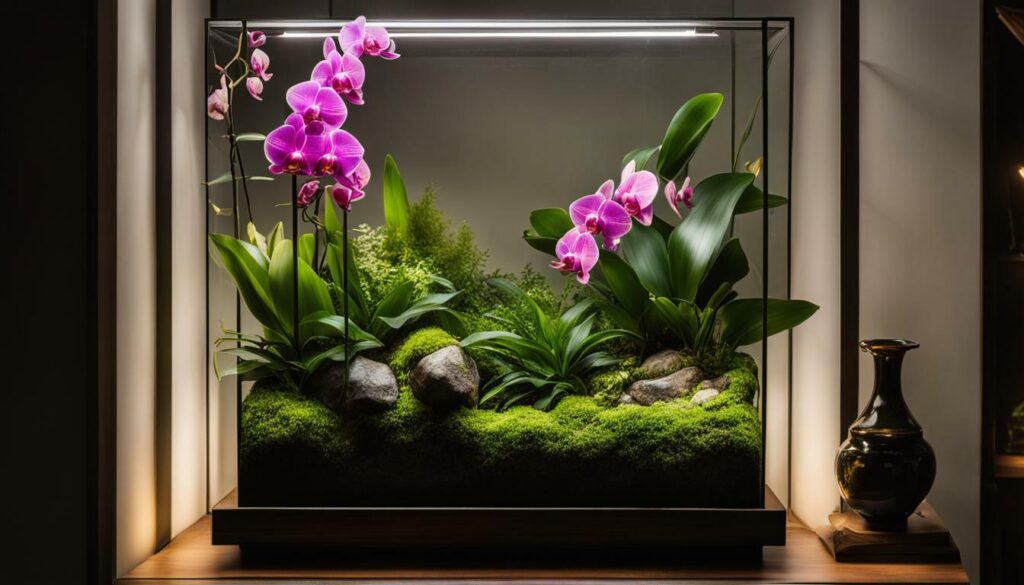
Best Orchid Species for Terrariums
| Orchid Species | Light Requirements | Temperature Range |
|---|---|---|
| Paphiopedilum orchids | Low to medium light | 65°F to 75°F (18°C to 24°C) |
| Miniature Phalaenopsis | Medium light | 70°F to 80°F (21°C to 27°C) |
| Masdevallia orchids | Low to medium light | 65°F to 70°F (18°C to 21°C) |
| Pleurothallids orchids | Low to medium light | 60°F to 70°F (15°C to 21°C) |
Once your terrarium is set up, it’s crucial to monitor and control the airflow, humidity, and temperature within the enclosure. Orchids thrive in environments with good air circulation, moderate humidity, and stable temperatures. Remember to adjust the airflow and humidity based on the specific needs of your orchid species.
Proper watering and fertilizing are essential for the health and growth of your orchids. Be sure to follow the recommended watering schedule and use a balanced orchid fertilizer to provide the necessary nutrients. With the right care, your orchids will thrive and reward you with beautiful blooms within the controlled environment of your terrarium.
By understanding the different terrarium ideas and selecting the best orchid species for your terrarium, you can create a stunning display of terrarium plants orchids. With proper care and attention to detail, your orchid terrarium will provide a thriving and visually appealing oasis in your home or office.
Setting Up Your Orchid Terrarium
Now that you have a better understanding of the terrarium plants orchids and the best orchid species for terrariums, it’s time to set up your own orchid terrarium. Creating an environment that replicates the natural conditions for orchids is crucial for their growth and blooming success. Here’s a step-by-step guide to help you set up your orchid terrarium: 1. Clean and sterilize your terrarium: Before adding any plants, it’s essential to clean and sterilize the terrarium to prevent the spread of disease. Use a mild bleach solution to thoroughly clean the tank and rinse it well with water before proceeding. 2. Choose the right substrate: Instead of using sand, soil, or gravel as the substrate, consider using an eggshell crate for the base layer of your terrarium. The crate provides excellent drainage and prevents waterlogging, which can be detrimental to orchids’ roots. 3. Add filler plants and props: To enhance the appearance of your orchid terrarium, you can include filler plants and props. Some suitable orchid companion plants include ferns, moss, and small bromeliads. Additionally, props like cork, driftwood, or moss can be strategically placed to cover the orchid pots and create a more natural look. 4. Control airflow and humidity: Proper airflow and humidity levels are crucial for orchids’ well-being. Consider using a hygrometer to monitor and maintain the ideal humidity level, which should be around 50-70%. To promote healthy growth, ensure good airflow by opening the terrarium occasionally or using a small fan on low settings. 5. Adjust for light and temperature: Orchids thrive in bright but indirect light. Position your terrarium in a location that receives filtered sunlight or use artificial grow lights to provide adequate light for your orchids. Additionally, maintain a temperature range of 70-80°F (21-27°C) during the day and a slightly cooler temperature at night. 6. Orchids in terrariums have different watering requirements than those grown in traditional pots. Avoid overwatering by allowing the substrate to slightly dry out before watering again. Use a water-soluble orchid fertilizer diluted to half-strength and apply it every two weeks during the growing season. By following these steps and providing the right conditions, you can create an orchid terrarium that offers a contained environment for your orchids to thrive. Enjoy the beauty and tranquility of these elegant plants in your own space.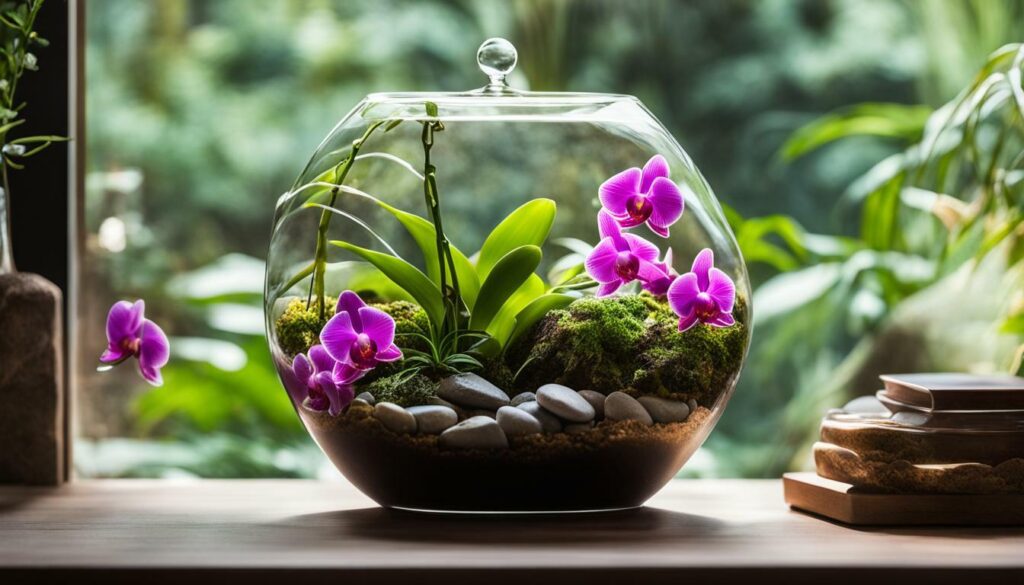
To ensure the successful growth of your terrarium plants orchids, creating the perfect environment is key. Orchids thrive in specific atmospheric conditions, and by controlling temperature, light, humidity, and airflow, you can provide an optimal habitat for these delicate beauties to flourish.
Firstly, it is important to choose orchid varieties that can handle low to medium levels of light and moderate temperatures. Paphiopedilum orchids, miniature Phalaenopsis, Masdevallia orchids, and Pleurothallids orchids are ideal options for terrariums. These varieties can adapt well to the conditions inside a terrarium, making them perfect choices for your indoor garden.
In addition to the orchids themselves, filler plants and companion plants can be added to the terrarium to enhance its appearance. These plants not only create a more natural look but also provide additional benefits such as improved air circulation and moisture retention. Consider incorporating plants like ferns, mosses, and small begonias to create a lush and visually appealing environment.
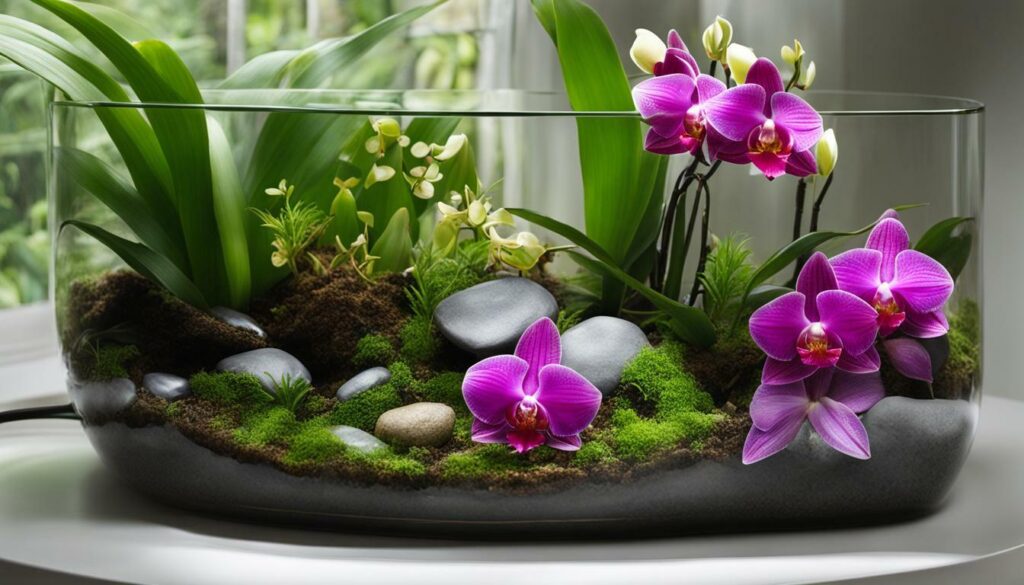
When setting up your terrarium, it is essential to clean and sterilize the tank to prevent the spread of disease. Instead of using traditional substrates such as sand, soil, or gravel, consider using an eggshell crate as the base layer. This will provide a stable foundation for your orchids and allow for better drainage to prevent waterlogging.
To add a touch of natural aesthetics, you can incorporate props like cork, driftwood, or moss to cover the pots and create a more realistic habitat for your orchids. These props not only add visual interest but also provide additional surfaces for the orchids to attach themselves to and grow.
Achieving the Perfect Balance
Controlling the airflow and humidity levels in your terrarium is crucial for the health and well-being of your orchids. Orchids thrive in environments with good air circulation and consistent humidity levels. Use a small fan to ensure proper airflow, making sure it is positioned to avoid direct drafts on the orchids.
Additionally, monitor and regulate the temperature and light inside the terrarium. Aim to provide a temperature range of 65-75°F (18-24°C) during the day and slightly cooler temperatures at night. Supplemental artificial lighting may be necessary to ensure your orchids receive adequate light, especially if natural light is limited.
Lastly, proper watering and fertilizing techniques are vital for the well-being of your orchids. Orchids should be watered when the potting medium is dry to the touch, and a balanced orchid fertilizer should be used regularly according to the product’s instructions. Overwatering or applying too much fertilizer can harm your orchids, so it is important to find the right balance.
By creating the perfect environment for your terrarium plants orchids, you can enjoy the beauty of these exquisite flowers while providing them with the conditions they need to thrive. Remember to continually monitor and adjust the atmospheric conditions within the terrarium to ensure the health and longevity of your orchids.
| Temperature | Light | Airflow | Humidity |
|---|---|---|---|
| 65-75°F (18-24°C) | Low to medium levels | Ensure good circulation | Consistent humidity levels |
Orchid Terrarium Maintenance
Proper maintenance is crucial to keeping your terrarium plants orchids thriving and blooming. To ensure the health of your orchids, it is important to control the airflow and humidity levels in the terrarium, adjust for light and temperature, and properly water and fertilize the orchids.
One of the key aspects of maintaining an orchid terrarium is to provide adequate airflow and humidity control. Orchids require good air circulation to prevent the growth of mold and fungus, but they also need high humidity levels to thrive. You can achieve this by placing a small fan near the terrarium to promote air movement and using a humidifier or misting the orchids regularly to maintain the desired humidity level.
When it comes to light and temperature, it is essential to provide the right conditions for your orchids. Most orchid varieties can handle low to medium levels of light, so placing the terrarium in an area with bright, indirect light is ideal. Avoid placing them in direct sunlight as it can cause leaf burn. Temperature-wise, most orchids prefer moderate temperatures ranging from 60 to 85 degrees Fahrenheit. Ensure that the terrarium is not exposed to extreme temperature fluctuations or drafts that can stress the orchids.
Watering and fertilizing orchids in the terrarium require careful attention. It is important to water orchids thoroughly but allow the roots to dry out between waterings to prevent rot. A good practice is to water the orchids in the morning to allow sufficient time for the foliage and crown to dry before the cooler evening temperatures. Fertilize your orchids regularly, following the instructions provided by the orchid species, to provide them with the necessary nutrients for healthy growth and blooming.
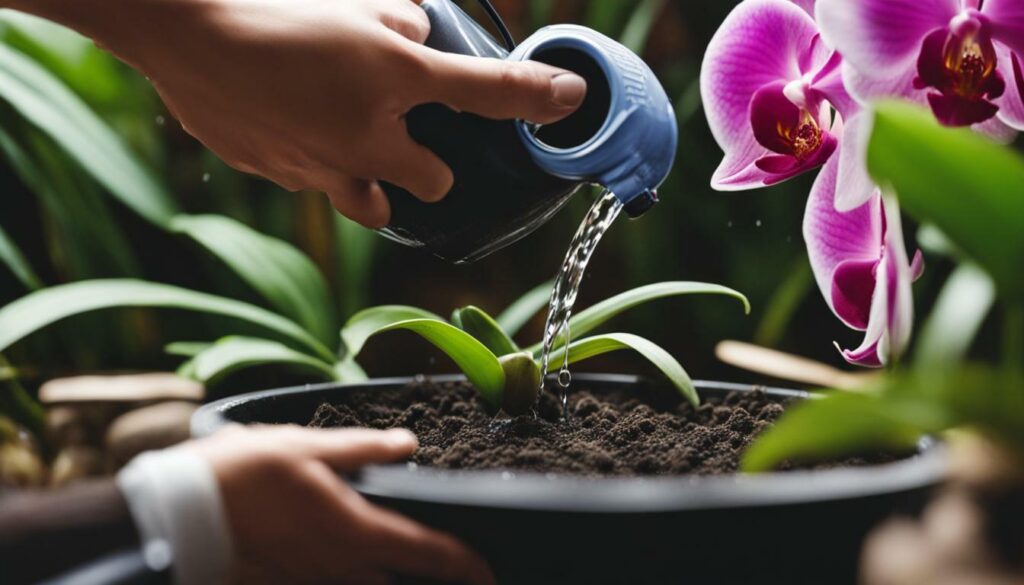
| Key Maintenance Tips for Orchid Terrariums |
|---|
| 1. Control airflow and humidity levels by using a small fan and a humidifier. |
| 2. Place the terrarium in an area with bright, indirect light to meet the orchids’ light requirements. |
| 3. Maintain moderate temperatures ranging from 60 to 85 degrees Fahrenheit. |
| 4. Thoroughly water the orchids, allowing the roots to dry out between waterings. |
| 5. Fertilize regularly following the instructions provided for the specific orchid species. |
Quote:
Proper maintenance is the key to creating a thriving orchid terrarium. By controlling the airflow, humidity, light, and temperature, you can create the perfect environment for your orchids to flourish. Don’t forget to water and fertilize them regularly to ensure their health and blooming. Remember, an orchid terrarium offers a contained space with specific atmospheric conditions that are optimal for orchid growth and enjoyment.
Adding Filler Plants and Props
Take your orchid terrarium to the next level by adding filler plants and props that not only complement your terrarium plants orchids but also enhance its overall appearance. Filler plants serve as a backdrop for your orchids, adding depth and texture to the terrarium. They can be chosen based on their compatibility with orchids and their ability to thrive in the terrarium environment.
Consider selecting filler plants that have similar light and humidity requirements as your orchids. Some popular choices for orchid companion plants include ferns, mosses, and small tropical foliage plants. These plants not only create a lush and natural feel but also provide additional moisture and help maintain humidity levels in the terrarium.
Props are also a great addition to your orchid terrarium, adding visual interest and creating a more natural environment. Cork, driftwood, and moss can be strategically placed to cover the orchid pots and create a realistic and aesthetically pleasing display. These props mimic the natural habitats of orchids and provide climbing surfaces for certain varieties.
| Orchid Companion Plants | Light Requirements | Humidity Requirements |
|---|---|---|
| Ferns | Low to medium | High humidity |
| Mosses | Low to medium | High humidity |
| Tropical Foliage Plants | Medium to bright | Moderate to high humidity |
By carefully selecting filler plants and props, you can create a stunning orchid terrarium that not only showcases your beautiful orchids but also creates a mini-ecosystem within your home. Experiment with different combinations of plants and props to find the perfect balance that suits your personal style and preferences. With a well-designed and thoughtfully arranged terrarium, you can transform your space into a captivating oasis of greenery and beauty.
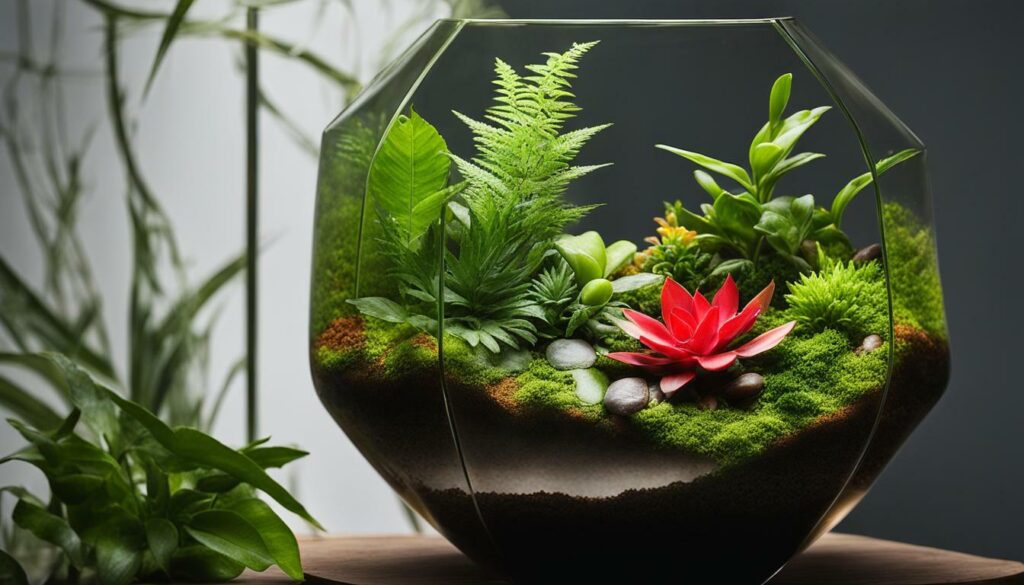
Before starting the exciting journey of orchid terrarium cultivation, it’s essential to properly clean and sterilize your terrarium to ensure the health of your plants. A clean and sanitized environment will help prevent the spread of diseases that can harm your terrarium plants orchids.
To clean your terrarium, begin by removing all plants, pots, and decorative items. Empty the terrarium of any soil, debris, or dead leaves. Use a mild detergent or dish soap mixed with warm water to clean the inside surfaces of the terrarium, including the glass walls and base. Rinse thoroughly with clean water to remove any soap residue.
After cleaning, it’s important to sterilize the terrarium to eliminate any remaining bacteria, fungi, or pests. You can do this by using a 10% bleach solution, mixing one part bleach with nine parts water. Use a spray bottle to apply the solution to all surfaces of the terrarium. Let it sit for about 15 minutes to ensure proper sterilization.
Once the sterilization process is complete, thoroughly rinse the terrarium with clean water to remove any traces of bleach. Allow it to air dry completely before proceeding with the setup of your orchid terrarium. This will ensure that your terrarium is free from any harmful pathogens or contaminants that could harm your terrarium plants orchids.
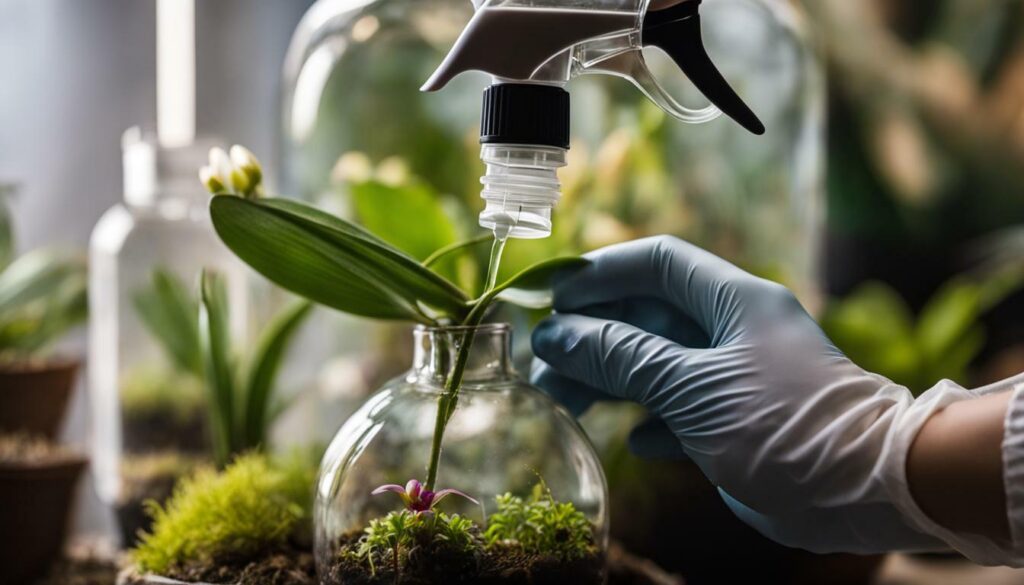
| Terrarium Cleaning Tips |
|---|
| Remove all plants, pots, and decorative items from the terrarium. |
| Empty the terrarium of any soil, debris, or dead leaves. |
| Clean the inside surfaces of the terrarium with a mild detergent or dish soap mixed with warm water. |
| Rinse the terrarium thoroughly with clean water to remove any soap residue. |
| Sterilize the terrarium using a 10% bleach solution, applying it to all surfaces and letting it sit for 15 minutes. |
| Rinse the terrarium again with clean water to remove any traces of bleach. |
| Allow the terrarium to air dry completely before proceeding with setup. |
Troubleshooting Common Issues
Even with the best care, terrarium plants orchids sometimes encounter problems that require troubleshooting and quick intervention. Understanding common issues and their solutions will help ensure the health and vitality of your orchids.
1. Root Rot
Root rot can occur when the orchid’s roots are constantly exposed to excessive moisture. This can happen if the terrarium is overwatered or if the drainage is poor. To prevent root rot, ensure that your terrarium has proper drainage and allow the substrate to slightly dry out between waterings. If you notice signs of root rot, such as dark, mushy roots, it is important to act quickly. Remove the affected roots and replant the orchid in fresh, well-draining substrate.
2. Pest Infestation
Common pests that can affect terrarium plants orchids include mealybugs, aphids, and spider mites. These pests can weaken the orchid and inhibit its growth. To combat pest infestations, regularly inspect your orchids for any signs of pests, such as sticky residue, webbing, or damage to the leaves. Remove any affected leaves or pests manually, and consider using organic pest control methods, such as neem oil or insecticidal soap, to treat the infestation.
3. Lack of Blooming
If your terrarium orchids are not blooming, there may be several factors at play. One common cause is insufficient light. Orchids thrive in bright, indirect light, so ensure that your terrarium receives enough light for the specific orchid species you are growing. Another possible cause of lack of blooming is improper temperature regulation. Orchids require a temperature drop at night to trigger blooming. Lastly, check your orchid’s fertilization routine. Providing the right balance of nutrients, such as a bloom-boosting orchid fertilizer, can encourage blooming.
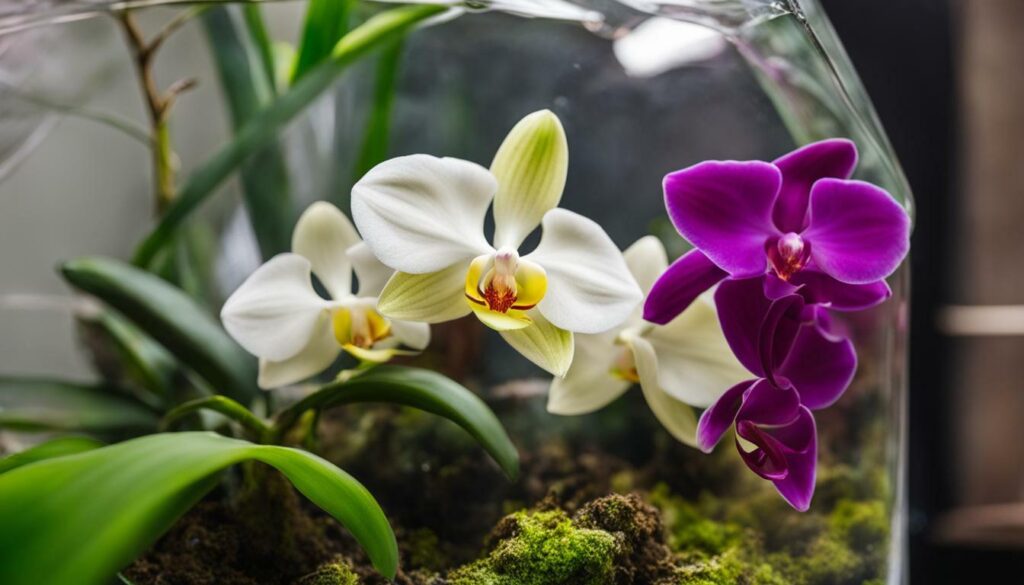
| Problem | Solution |
|---|---|
| Root Rot | – Improve drainage in the terrarium – Allow substrate to slightly dry out between waterings – Remove affected roots and replant in fresh substrate |
| Pest Infestation | – Regularly inspect orchids for pests – Remove pests manually – Use organic pest control methods, such as neem oil or insecticidal soap |
| Lack of Blooming | – Provide sufficient light for orchids – Ensure proper temperature drop at night – Use a bloom-boosting orchid fertilizer |
Conclusion
Congratulations, you are now equipped with the knowledge and tips to successfully grow terrarium plants orchids and transform your space into a tropical paradise. Creating an orchid terrarium provides you with the opportunity to control the temperature, light, humidity, and airflow, ensuring optimal conditions for your orchids to thrive and bloom.
When selecting orchid varieties for your terrarium, choose ones that can tolerate low to medium levels of light and moderate temperatures. Paphiopedilum orchids, miniature Phalaenopsis, Masdevallia orchids, and Pleurothallids orchids are great choices. These orchids will appreciate the controlled environment of your terrarium.
In addition to orchids, you can enhance the appearance of your terrarium by adding filler plants and companion plants. These plants not only add visual interest but also create a more natural and balanced ecosystem within your terrarium.
Before setting up your orchid terrarium, it is important to clean and sterilize the tank. This ensures that any potential diseases or pests are eliminated, preventing harm to your terrarium plants orchids. Instead of using traditional substrates like sand, soil, or gravel, consider using an eggshell crate as the base layer for better drainage and air circulation.
Don’t forget to include props like cork, driftwood, or moss to cover the orchid pots and create a more natural and aesthetically pleasing look. These props will also provide additional surfaces for your orchids to grow and attach to.
Managing the airflow, humidity levels, light, temperature, and proper watering and fertilizing are essential for the well-being of your terrarium plants orchids. Regularly monitor and adjust these factors to ensure your orchids are in the optimal environment for growth.
In conclusion, an orchid terrarium offers a contained environment with specific atmospheric conditions that are ideal for orchids to thrive. With the right care and attention, your terrarium plants orchids will reward you with stunning blooms and a touch of tropical beauty in your own space.
Can Bonsai Trees and Orchids be Grown Together in a Terrarium?
Yes, terrarium plants and bonsai trees can be grown together in a terrarium. Both bonsai trees and orchids thrive in a humid environment, making them suitable companions in a closed terrarium. However, it’s important to ensure that both species are compatible in terms of light, temperature, and humidity requirements.
FAQ
Can any orchid variety be grown in a terrarium?
It is important to choose orchid varieties that can handle low to medium levels of light and moderate temperatures, such as Paphiopedilum orchids, miniature Phalaenopsis, Masdevallia orchids, and Pleurothallids orchids.
What other plants can be added to the orchid terrarium?
Fillers plants and companion plants can be added to the terrarium to enhance its appearance and provide additional visual interest.
How should I prepare the terrarium before setting it up?
It is necessary to clean and sterilize the tank to prevent the spread of disease and ensure a healthy environment for your orchids.
What can I use as a substrate for the terrarium?
Instead of using sand, soil, or gravel, an eggshell crate can be used for the base layer of the terrarium.
How can I create a more natural look in the terrarium?
Props like cork, driftwood, or moss can be added to cover the orchid pots and create a more natural look in the terrarium.
How should I control airflow and humidity in the terrarium?
Controlling airflow and humidity levels is important for orchid care. Proper ventilation, misting, and using a hygrometer can help to maintain the ideal conditions.
How should I adjust the light and temperature in the terrarium?
It is important to place the terrarium in an area with the right amount of light for the specific orchid varieties. Temperature can be controlled by adjusting the position of the terrarium or using a thermostat.
How often should I water and fertilize the orchids in the terrarium?
Watering and fertilizing frequency should be adjusted according to the specific needs of the orchid varieties. It is essential to avoid overwatering and provide proper nutrient balance.
Can I add other plants to the orchid terrarium?
Yes, other filler plants and companion plants can be added to enhance the appearance and provide additional benefits for the orchids.
How can I prevent the spread of diseases in the terrarium?
Cleaning and sterilizing the terrarium before setting it up is crucial to prevent the spread of diseases that can harm the orchids.
What should I do if I encounter issues with my orchid terrarium?
Troubleshooting common issues is an important part of orchid care. By identifying the problem and implementing appropriate solutions, you can ensure the health and vitality of your orchids.

